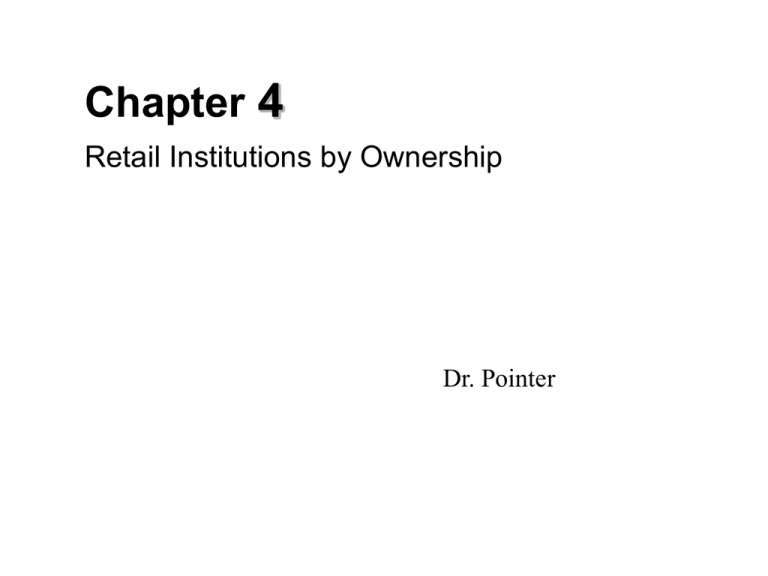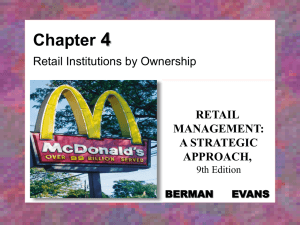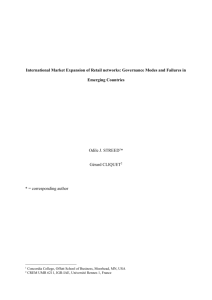Chapter 1
advertisement

Chapter 4 Retail Institutions by Ownership Dr. Pointer Chapter Objectives To show the ways in which retail institutions can be classified To study retailers on the basis of ownership type and examine the characteristics of each To explore the methods used by manufacturers, wholesalers, and retailers to exert influence in the distribution channel 4-2 Figure 4.1 A Classification Method for Retail Institutions I Ownership II Store-based Retail Strategy Mix III Nonstore-based Retail Strategy Mix 4-3 Ownership Forms Independent Chain Franchise Leased department Vertical marketing system Consumer cooperative 4-4 Each Ownership Form Serves a Unique Marketing Niche • Independents are targeted and have loyal followers based on friendly appeal • Chains benefits from widely known image and economies of scales and mass promotions • Franchisors have strong geographic coverage • Vertical integrated channels gives firms greater control • Leased departments is a good partnership for outside parties and store operators to accomplish mutual goals 4-5 Independent Retailers 2.1 million independent U.S. retailers 50% of these are run by owners and their families Account for 40% of total stores and 3% of U.S. store sales Why so many? Ease of entry So market is very competitive and very high failure rate 4-6 Competitive State of Independents Advantages Disadvantages Flexibility in formats, Lack of bargaining locations, and strategy power Control over investment Lack of economies of costs and personnel scale functions, strategies Labor intensive Personal image operations Consistency and Over-dependence on independence owner Strong entrepreneurial Limited long-run leadership planning 4-7 Store-based Retail Strategy Mix Convenience store Conventional supermarket Food-based superstore Combination store Box store Warehouse store Specialty store 4-8 Variety store Traditional department store Full-line discount store Off-price chain Factory outlet Membership club Flea market Chain Retailers Operates multiple outlets under common ownership Engages in some level of centralized or coordinated purchasing and decision making In the U.S., there are roughly 100,000 retail chains operating about 750,000 establishments (-5%) of all retail stores Account for about 60% of Retail Sales 4-9 Competitive State of Chains Advantages Bargaining power Cost efficiencies Efficiency from computerization, sharing warehouse and other functions Defined management philosophy Considerable efforts in long-run planning 4-10 Disadvantages Limited flexibility Higher investment costs Complex managerial control Limited independence among personnel Nonstore-based Retail Strategy Mix and Nontraditional Retailing Direct marketing Direct selling Vending machine World Wide Web Other emerging retail formats 4-11 Franchising A contractual agreement between a franchisor and a retail franchisee, which allows the franchisee to conduct business under an established name and according to a given pattern of business Franchisee pays an initial fee and a monthly percentage of gross sales in exchange for the exclusive rights to sell goods and services in an area 4-12 Franchise Formats Product/ Trademark franchisee acquires the identity of a franchisor by agreeing to sell products and/or operate under the franchisor name franchisee operates autonomously 2/3 of retail franchising sales 4-13 Business Format franchisee receives assistance: location, quality control, accounting systems, start-up practices, management training common for restaurants, real estate Figure 4.5 Business Qualifications Sought by McDonald’s for Potential Franchisees Personal Integrity Entrepreneurial Spirit Ability to motivate and train Financial resources Ideal Franchisee Ability to manage finances 4-14 Willingness to complete training Willingness to devote time Figure 4.6 Structural Arrangements in Retail Franchising Auto/truck dealer Petroleum products Manufacturerretailer Voluntary WholesalerRetailer Cooperative Service type -retailer 4-15 Consumer electronics Auto Accessories Consumer electronics Auto Accessories Auto rentals Hotels/motels fast foods Wholesaler-Retailer Structural Arrangements Voluntary: A wholesaler sets up a franchise system and grants franchises to individual retailers Cooperative: A group of retailers sets up a franchise system and shares the ownership and operations of a wholesaling organization 4-16 Figure 4.7 Franchises and Business Opportunities At the FTC franchising site www.ftc.gov/bcp/franchise/netfran.htm There are many free downloads about franchise opportunities 4-17 Competitive State of Franchising Advantages small capital required acquire well-known names operating/manageme nt skills taught cooperative marketing possible exclusive selling rights less costly per unit 4-18 Disadvantages oversaturation could occur franchisors may overstate potential locked into contracts agreements may be cancelled or voided royalties are based on sales, not profits From the Franchisor’s Perspective Benefits Potential Problems national or global presence possible qualifications for franchisee/ operations are set and enforced money obtained at delivery royalties represent revenue stream potential for harm to reputation lack of uniformity may affect customer loyalty ineffective franchised units may damage resale value, profitability potential limits to franchisor rules 4-19 Leased Departments • A leased department is a department in a retail store that is rented to an outside party – The proprietor is responsible for all aspects of its business and pays a percentage of sales as rent – The department store sets operating restrictions to ensure consistency and coordination 4-20 Competitive State of Leased Departments Benefits Potential Pitfalls provides one-stop lessees may negate shopping to store image customers procedures may lessees handle conflict with management department store reduces store costs problems may be blamed on provides a stream of department store revenue rather than lessee 4-21 Vertical Marketing Systems • VMS consists of all the levels of independently owned businesses along a channel of distributions • Three functions and ownership ●Independent systems ● Partially integrated systems ● Fully integrated systems 4-22 Figure 4.8 Vertical Marketing Systems Independent Channel System Functions: Manufacturing Wholesaling Retailing Ownership: Independent Manufacturer Independent Wholesaler Independent Retailer 4-23 Figure 4.8 Vertical Marketing Systems Partially Integrated Channel System Functions: Manufacturing Wholesaling Retailing Ownership: Two channel members own all facilities and perform all functions 4-24 Figure 4.8 Vertical Marketing Systems Fully Integrated Channel System Functions: Manufacturing Wholesaling Retailing Ownership: All production and distribution functions are performed by one channel member 4-25 Other Factors to Consider • Dual distribution channel (dual marketing) engages in multi channels distribution to reach different consumers • Channel control – usually one member of channel dominates the decisions made in channel 4-26 Figure 4.9 Sherwin-Williams’ Dual Vertical Marketing System Sherwin William brand of paint Co-owned shores sell to consumers Dutch Boy brand of paints Independent Wholesalers Retailers and others Customers 4-27 Web-Based Exercise Subway is one of the largest retail franchisors in the world Based on the information found under Franchise Opportunities on the Subway website, would you be interested in becoming a Subway franchisee? 4-28 Questions 4-29











